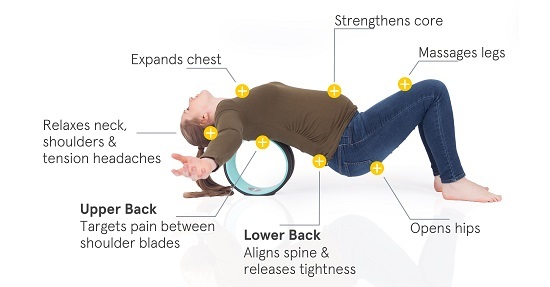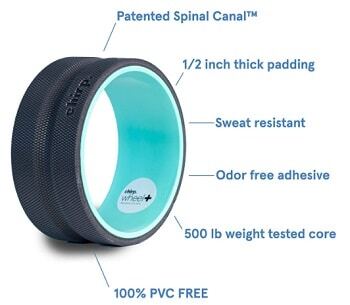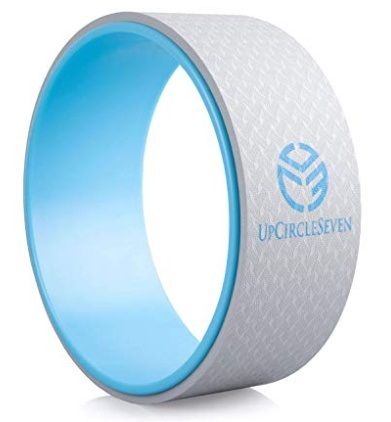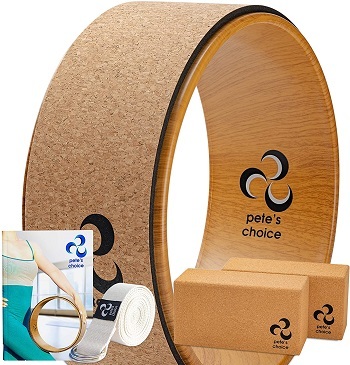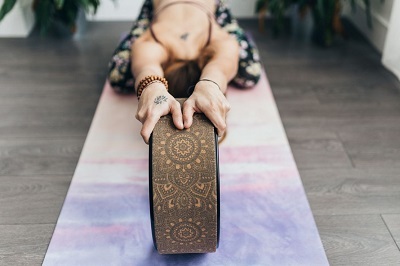Using a back roller wheel is one of the easiest, fastest, and most effective tools for stretching and massaging all the muscles along your spine – for quick back pain relief, back popping, increased flexibility, and posture improvement.
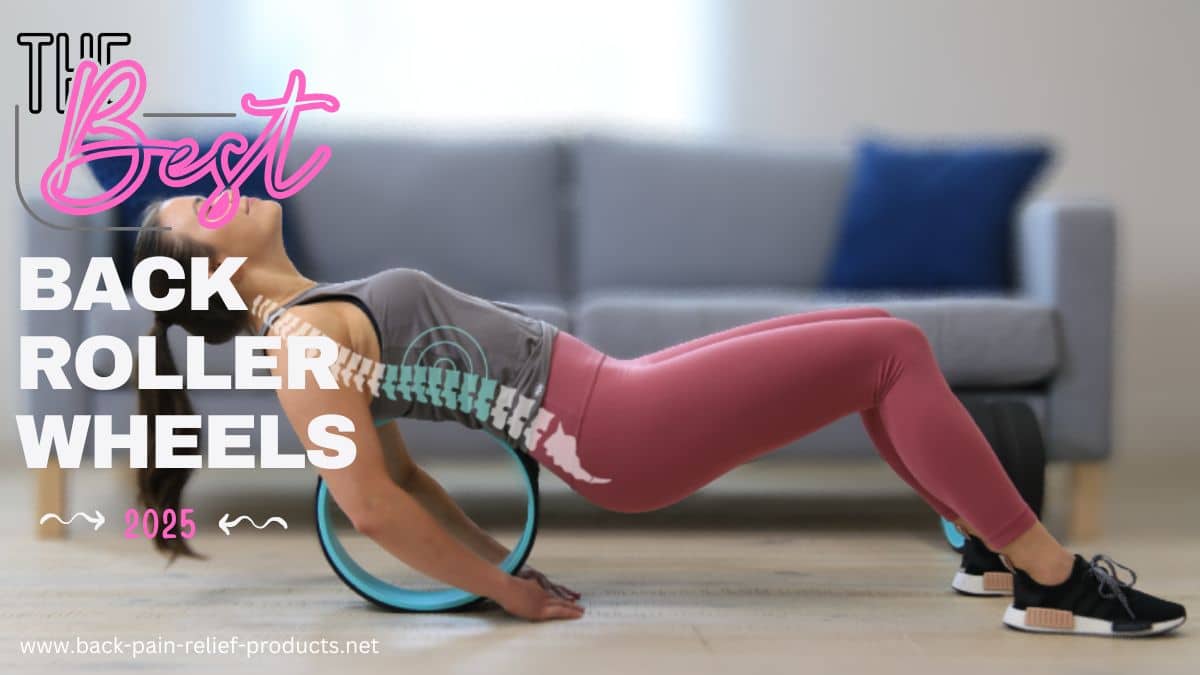
A durable yet comfortable yoga wheel can increase your flexibility and range of motion, and relieve back pain from muscle tightness, back muscle spasms, sciatica, muscle knots, and more – in less than 5 minutes.
However:
It’s important to buy a back roller wheel that is sturdy (to support your weight) yet flexible and comfortable.
We got the wheel rolling and found the 5 best back roller wheels for back pain relief, increased flexibility (bending without pain), increased range of motion, or just mastering that Yoga pose you’ve been struggling with.
In a Hurry?
See the 5 best back roller wheels, followed by our full reviews, pros, and cons.
This post may contain affiliate links, at no extra cost to you
Overview
- Is a Yoga Wheel Good for Back Pain?
- The 4 Best Back Roller Wheels (for Spine Traction and a Good Back Crack)
- Back Roller Wheel Pros and Cons
- Back Roller Wheel vs. Foam Roller
- How to Use a Back Roller Wheel (Best Exercises)
- Is a Back Roller Wheel Safe? Can You Get Injured?
- What Size Yoga Wheel Should I Use?
- Can You Crack Your Back Using a Yoga Wheel?
- Can You Use a Yoga Wheel for Neck Pain?
Is a Yoga Wheel Good for Back Pain?
Using a yoga wheel to stretch and lengthen the spine gradually improves your posture, reduces back pain, and fixes the negative effects caused by sitting too much or working out too hard.
The tough core re-aligns your spine and returns its natural S-curve while opening your chest and making breathing easier – all in 5 minutes a day.
It relieves stress and promotes healing from degenerative discs or bulging discs as well.
Compared to an arched back stretcher, the back roller wheel can also be used in various yoga poses and exercises, while the orthopedic back stretcher is typically used in a lying-down position.
The 4 Best Back Roller Wheels (for Spine Traction and a Good Back Crack)
Through our research, here are the 4 best back roller wheels, and below you’ll find exactly how to use a back stretching wheel to relieve lower, mid, and upper back pain – in minutes.
1. Chirp Wheel+ – Best Back Roller Wheel
$84 AT CHIRP 3-pack
- Weight support – 500 lbs.
- Material – rigid core made of an injection-molded ABS plastic, wrapped in EVA foam
- Warranty – lifetime warranty and 100-day trial with free returns
✅ Pros – Fits perfectly between the shoulder blades, the only wheel with a gap to protect the spine, unique 4-way stretch
❌ Cons – Not suited for more advanced users or those with severe back pain
The Chirp Wheel+ is a new and improved take on the classic yoga wheel – a tool used to stretch muscles and improve balance in yoga practice.
The Chirp Wheel follows the spine’s natural curve to fit perfectly between the shoulder blades.
When you roll your back over it – it stretches your back muscles, massages them, and at the same time, provides spine traction and takes the pressure off the discs.
You won’t find the unique 4-way stretch (simultaneously stretches in 4 directions) in standard back wheels.
This helps with:
- Posture correction
- Flexibility
- Mobility
- Muscle tension release
- Core strengthening
- Expanding the chest area
It can also be used in the neck area – for quick relief from neck pain and tension headaches.
The Chirp Wheel is easy to use, has no learning curve, and can be used every day. It is great for mild-to-moderate back pain, especially in the mid-back and upper back.
It is the best-selling back roller wheel in 2025 (and for good reasons), and is now FSA/HSA approved!
The new model – Chirp Wheel+ – comes in 5 sizes:
- 12 inches – for gentle pressure
- 10 inches – medium pressure
- 6 inches – deep tissue pressure, plus back support and massage while sitting in a chair
- 4 inches – a neck roller, designed to target key pressure points in your neck to reduce tension headaches and relieve neck pain
- XL – wider base for added stability, and thicker foam for extra comfort
Or, you can now get different bundles – starting at $84 (for the 3-pack) – with free shipping.
You can get each one separately or all 3/4 in a set. XL is sold separately.
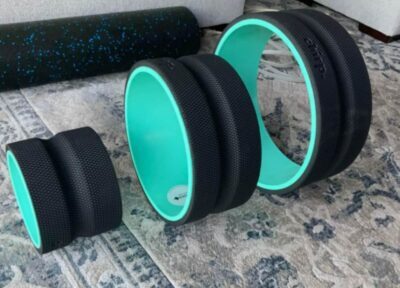
We recommend using any massage wheel for at least 30 days before returning, to allow the body to go through some correction and to get properly aligned and past the initial mild soreness you may experience.
Chirp Wheel vs. Yoga Wheel
Is there a difference between a standard yoga wheel and the Chirp Wheel?
A standard yoga wheel does not have the unique 4-way stretch that the Chirp wheel offers.
This patented stretch expands your vertebrae and pulls your spine from 4 directions.
The spinal canal technology reduces the discomfort of the stretch and saves your spine from unnecessary pressure.
Also, the Chirp Wheel is the only one that is designed to protect your spine when you roll on it.
There is a gap where the spine rests to avoid unnecessary pressure on the spinal discs.
Chiropractor Dr. Sharon Lark especially recommends the small, 6-inch Chirp Wheel because it’s perfect for travel, can fit into smaller areas between the spine, provides comfort, and helps avoid pressure on the shoulder blades.

2. UpCircleSeven – Budget Pick
VIEW ON AMAZON $52
- Sizes – 12″ x 5″/ 10″ x 5″/ 6″ x 5″, or the whole set.
- Material – Closed Cell Sweat Resistant Padding + ABS Frame
- Padding – 8 mm
- Warranty – 10 years
✅ Pros – High weight support, strong and well-made, easy to clean
❌ Cons – Some users may find it too hard or uncomfortable
The UpCircleSeven wheel can support a higher-than-average weight (550 lbs) and has the thickest padding (8 mm) of all backstretch wheels on the market.
You can safely use this back-stretching wheel for deep backbends, gentle inversion, decompressing your spine, and for tight muscles in your hips, thighs, and hamstrings as well.
It’s durable and sturdy, yet comfortable, and hundreds of Amazon users have reported a significant reduction in their back pain and sciatica after using it.
3. Pete’s Choice Cork Yoga Wheel – Eco-Friendly
VIEW ON AMAZON $53
- Size – 13-inch diameter, 5 inches wide, and 3/4 inch thick
- Weight support – not found
- Material – tree bark
- Warranty – Lifetime
✅ Pros – Sustainable and eco-friendly, extra firm and high density, bonus eBook, and free yoga strap
❌ Cons – Unspecified weight support limit
Pete’s Choice cork yoga wheel has an eco-friendly and sustainable version of a spine roller wheel you may want to consider.
The cork wheel material (tree bark) is both renewable and recyclable, yet durable and can support your back (supports up to 350 lb), palms, and feet while in motion over it.
It’s easy to clean, and it is sweat-resistant, so it will not accumulate moisture.
The cork around the wooden part gives a bit of cushion so it’s comfortable to rest on.
Backed with a lifetime guarantee (and comes with a free booklet with 16 yoga poses for back pain), this cork yoga wheel is the best choice for environmentally aware people.
4. Risefit Dharma Yoga Wheel – Highest Weight Support
VIEW ON AMAZON $29
- Size – 13″ x 5″ x 3/4″
- Material – foam TPE and a strong inner ABS tube
- Warranty – 3 years
- Weight limit – 1043 lbs.
✅ Pros – Extra high weight support, durable and well-made,
❌Cons – Harder to clean
The Risefit back bend wheel supports up to 1043 lbs. and is made with eco-friendly foam TPE and a strong inner ABS tube that ensures you roll on the wheel with ease, safety, and support.
The textured outer layer prevents it from being slippery; however, it is a bit harder to clean.
We chose this wheel because we think it will support people of all sizes and weights safely, plus it looks beautiful and the vibrant colors give some happy vibes to it.
Back Roller Wheel Pros and Cons
Using a Yoga Wheel properly can increase your flexibility, correct your posture, increase your range of motion, stretch your back without help, and increase balance and safety if you are practicing yoga.
However, if not used correctly, it can raise your risk of being injured (especially if you bought a cheap one that will break down under you!).
Also, the roller wheel takes up space and is more expensive than a regular foam roller.
If you are hesitant about using a yoga wheel, you can try an orthopedic back stretcher instead, which costs half the price and is also a great way to decompress your spine – without having to roll back and forth or any other type of effort.
Physical therapists Bob and Brad believe that while the yoga wheel is not necessarily a bad product, there are better alternatives available, including doing press-ups for back extensions, using an inexpensive ball for mid-back stretches, and using a vibrating foam roller for muscle pliability and stretching.
Back Roller Wheel vs. Foam Roller
Foam rollers are usually longer, but much less sturdy than back roller wheels.
On the other hand, they can cover larger muscle groups (such as the hamstrings and glutes).
Foam rollers tend to soften and break down over time, while yoga wheels are sturdier and keep their shape indefinitely.
Also, using a back roller wheel is one of the best ways to get in between your shoulder blades – without applying unnecessary pressure on your spine.
A smaller yoga wheel can be used to roll hard-to-reach areas that the foam roller just can’t reach.
A spine wheel can also be used for a variety of home exercises, including yoga, core exercises, and more.
Have you considered using a vibrating foam roller? it takes foam rolling to a whole new level!
How to Use a Back Roller Wheel (Best Exercises)
The first time I tried to use a yoga wheel was not a pretty sight.
I rolled around on that thing like a baby giraffe trying to walk for the first time. But it gets better. I promise.
Here are 2 simple exercises to do with your back roller wheel:
The basic and best way (pose) to use a yoga roller wheel for back and shoulder pain relief is by doing a deep backbend.
Position the yoga wheel in the center of your back, between your shoulders, and lie over it. Bring your arms out to the side (or up over your head) and let your head hang back.
Here’s a short video demonstrating how to prepare for the back bend:
Another highly effective stretch is the child’s pose:
Get into the child’s pose with your knees wide apart and place both hands on the sides of the wheel at the front of your mat.
Keep your head down and roll the wheel forward slowly as you press your chest to the ground.
This stretch really opens up the shoulders.
The Child’s pose is a classic, restful pose that is proven to help stretch the hips, thighs, and lower back in a gentle and relaxing way.
Is a Back Roller Wheel Safe? Can You Get Injured?
Stretching on a yoga wheel is generally safe for most people, but it is important to keep in mind that everyone’s body is different and some people may need to modify or avoid certain poses or stretches.
If you are a beginner, start with fewer deep stretches, and always make sure it is centered under you.
When using it for backbends, having some extra props handy, such as blocks or blankets, can be helpful and prevent injuries.
People with osteoporosis and osteopenia have to be careful when doing extreme spinal movements.
In the case of severe osteoporosis, forced spinal flexion can result in a fracture.
Start gradually and work your way up. If you feel more than mild pain and discomfort – it’s time to stop.
Important Warning – always have your hair tied up, otherwise you can potentially scalp yourself. The same goes for wearing a hoodie or slippery clothes that may make you fall off it.
For a more gentle spine stretch, see the top 5 orthopedic back stretchers of 2025.
What Size Yoga Wheel Should I Use?
Each wheel size provides a different pressure.
The larger wheels are better for beginners as they help ease into the stretch without overstretching tight muscles.
The smaller ones are better for deep tissue and muscles that need extra pressure and for posture correction while you sit.
Can You Crack Your Back Using a Yoga Wheel?
Rolling on the yoga wheel and massaging the muscles around your spine can definitely help you crack your back.
The pop usually happens after you’ve loosened up your muscles a bit, and you lift your hands over your head.
You may also feel your vertebrae pop back into place (in a totally feel-good way).
This will be a good sign that your spine is flexible and getting movement.
Can You Use a Yoga Wheel for Neck Pain?
Yes, you can use a small yoga wheel to roll over your neck muscles, massage them, and stretch them while decompressing your cervical spine.
The Chirp Wheel comes in 5 sizes, and the smallest one (4-inch) is perfect for neck pain release.
It can target key pressure points in your neck and shoulders, and even reverse tech-neck.
Lie down and place the 4” Chirp Wheel+ under your neck.
Then relax and let your neck stretch over the wheel. To boost the stretch, begin to roll back and forth on the wheel by bending and straightening your legs. Use your hands for balance.
To your health and happiness,
The Back Pain Relief Products Team
References
Front. Psychol., 11 May 2017 | https://doi.org/10.3389/fpsyg.2017.00752
